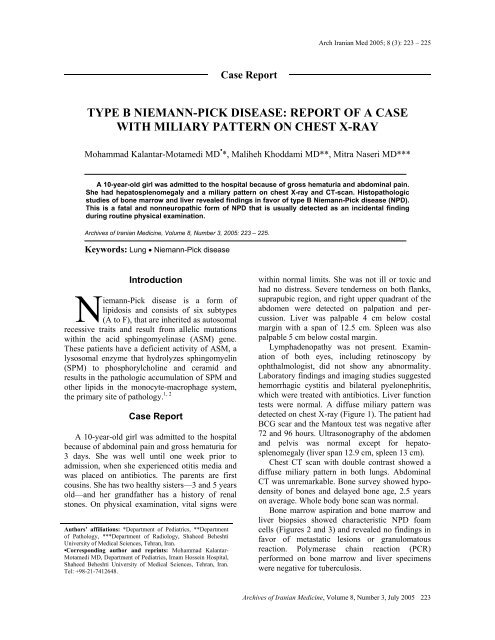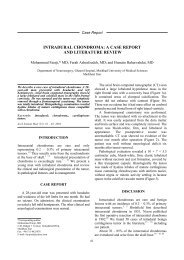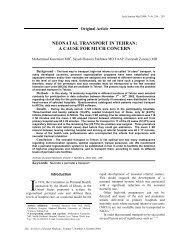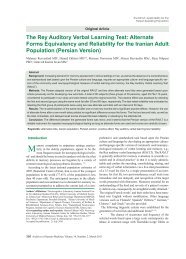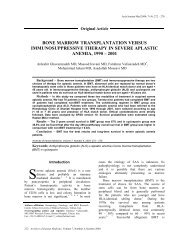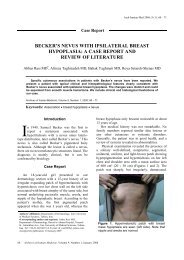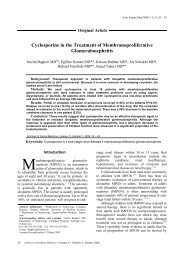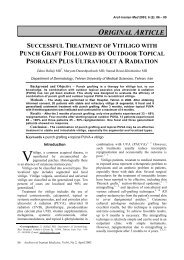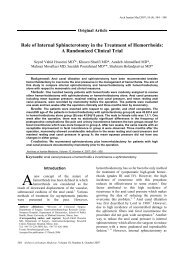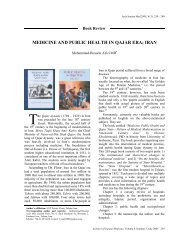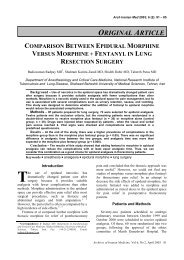TYPE B NIEMANN-PICK DISEASE: REPORT OF A CASE WITH ...
TYPE B NIEMANN-PICK DISEASE: REPORT OF A CASE WITH ...
TYPE B NIEMANN-PICK DISEASE: REPORT OF A CASE WITH ...
Create successful ePaper yourself
Turn your PDF publications into a flip-book with our unique Google optimized e-Paper software.
Arch Iranian Med 2005; 8 (3): 223 – 225Case Report<strong>TYPE</strong> B <strong>NIEMANN</strong>-<strong>PICK</strong> <strong>DISEASE</strong>: <strong>REPORT</strong> <strong>OF</strong> A <strong>CASE</strong><strong>WITH</strong> MILIARY PATTERN ON CHEST X-RAYMohammad Kalantar-Motamedi MD • *, Maliheh Khoddami MD**, Mitra Naseri MD***A 10-year-old girl was admitted to the hospital because of gross hematuria and abdominal pain.She had hepatosplenomegaly and a miliary pattern on chest X-ray and CT-scan. Histopathologicstudies of bone marrow and liver revealed findings in favor of type B Niemann-Pick disease (NPD).This is a fatal and nonneuropathic form of NPD that is usually detected as an incidental findingduring routine physical examination.Archives of Iranian Medicine, Volume 8, Number 3, 2005: 223 – 225.Keywords: Lung • Niemann-Pick diseaseIntroductionNiemann-Pick disease is a form oflipidosis and consists of six subtypes(A to F), that are inherited as autosomalrecessive traits and result from allelic mutationswithin the acid sphingomyelinase (ASM) gene.These patients have a deficient activity of ASM, alysosomal enzyme that hydrolyzes sphingomyelin(SPM) to phosphorylcholine and ceramid andresults in the pathologic accumulation of SPM andother lipids in the monocyte-macrophage system,the primary site of pathology. 1, 2Case ReportA 10-year-old girl was admitted to the hospitalbecause of abdominal pain and gross hematuria for3 days. She was well until one week prior toadmission, when she experienced otitis media andwas placed on antibiotics. The parents are firstcousins. She has two healthy sisters—3 and 5 yearsold—and her grandfather has a history of renalstones. On physical examination, vital signs wereAuthors’ affiliations: *Department of Pediatrics, **Departmentof Pathology, ***Department of Radiology, Shaheed BeheshtiUniversity of Medical Sciences, Tehran, Iran.•Corresponding author and reprints: Mohammad Kalantar-Motamedi MD, Department of Pediatrics, Imam Hossein Hospital,Shaheed Beheshti University of Medical Sciences, Tehran, Iran.Tel: +98-21-7412648.within normal limits. She was not ill or toxic andhad no distress. Severe tenderness on both flanks,suprapubic region, and right upper quadrant of theabdomen were detected on palpation and percussion.Liver was palpable 4 cm below costalmargin with a span of 12.5 cm. Spleen was alsopalpable 5 cm below costal margin.Lymphadenopathy was not present. Examinationof both eyes, including retinoscopy byophthalmologist, did not show any abnormality.Laboratory findings and imaging studies suggestedhemorrhagic cystitis and bilateral pyelonephritis,which were treated with antibiotics. Liver functiontests were normal. A diffuse miliary pattern wasdetected on chest X-ray (Figure 1). The patient hadBCG scar and the Mantoux test was negative after72 and 96 hours. Ultrasonography of the abdomenand pelvis was normal except for hepatosplenomegaly(liver span 12.9 cm, spleen 13 cm).Chest CT scan with double contrast showed adiffuse miliary pattern in both lungs. AbdominalCT was unremarkable. Bone survey showed hypodensityof bones and delayed bone age, 2.5 yearson average. Whole body bone scan was normal.Bone marrow aspiration and bone marrow andliver biopsies showed characteristic NPD foamcells (Figures 2 and 3) and revealed no findings infavor of metastatic lesions or granulomatousreaction. Polymerase chain reaction (PCR)performed on bone marrow and liver specimenswere negative for tuberculosis.Archives of Iranian Medicine, Volume 8, Number 3, July 2005 223
Type B Niemann-Pick diseaseABFigure 1 (A and B). Chest X-ray showing bilateral diffuse miliary pattern.DiscussionType A NPD, with Ashkenazi Jewish predilection,is a fatal disorder of infancy characterizedby failure to thrive, hepatosplenomegaly, cherryred maculae, and rapidly progressive neurodegenerativecourse, presents as psychomotor and neurodevelopmentalregression, loss of motor functionand intellectual capabilities, spasticity, and rigiditythat leads to death by 2 – 4 years of age. 2 Exceptfor type B, other types of NPD also have a variableneurodegenerative course. Type B disease ispanethnic and is characterized by hepatosplenomegaly,hyperlipidemia, and variablesurvival to adulthood. Cherry red spot or haloes arerarely seen in the maculae of type B patients. Theydo not have neurodegeneration and have normal IQand intellectual capabilities. Most cases havedecreased pulmonary diffusion due to infiltrationof both alveoli and interstitium. Sea bluehistiocytes become evident in late childhood.Progression happens by 15 – 20 years of age andmay cause life-threatening bronchopneumonia andcorpulmonale. In severe forms, liver involvementleads to life-threatening cirrhosis, portal hypertension,ascites, and pancytopenia due to hypersplenismthat may require splenectomy. However,this should be avoided as splenectomy leads to theprogression of pulmonary involvement. 1Liver dysfunction, pulmonary disease, retinalstigmata, and growth restriction may also bepresent, but are features that are more variable.Although the clinical manifestations in type Apatients are uniform, there is marked variability inthe phenotype among type B patients, ranging fromsevere disease in childhood to patients with mildercourse. Duchateau et al reported an asymptomatic22-year-old man with NPD type B diagnosed bybone marrow biopsy and ASM assessment.Pulmonary involvement was discovered inciden-Figure 2. Bone marrow biopsy showingcharacteristic Niemann-Pick disease foam cells.Figure 3. Liver biopsy showing characteristicNiemann-Pick disease foam cells.224Archives of Iranian Medicine, Volume 8, Number 3, July 2005
M. Kalantar-Motamedi, M. Khoddami, M. Naseritally during the evaluation of a dry cough. ChestX-ray and CT scan showed smooth interlobularsepta thickening and a subtle ground glass pattern. 3Gonzalez-Reimers et al also reported anotherasymptomatic 39-year-old male patient in whompulmonary involvement became evident as theinitial diagnosis. 4 Abnormal linear growth anddelayed skeletal maturation are common inchildren and adolescents with type B disease; shortstature and low weight are significantly correlatedwith large organ volumes, delayed bone age, andlow insulin-like growth factor-1 (IGF-1) levels.NPD is diagnosed by demonstrating foam cellsin bone marrow and liver biopsies, which arecharacteristic NPD cells and are seen in all types.Type B is the only type with pulmonaryinvolvement characterized by a micronodular ormiliary pattern on chest X-ray and CT scan. ASMactivity is also reduced in isolated leukocytes orcultured cells and two mutations within the ASMgene may be identified. Many ASM mutationshave been identified in unrelated type A and Bpatients. 5, 6 Three of these, R496L, L302P, andFsP330, account for 95% of the mutant alleles inAshkenazi Jewish type A patients 7 and a singlemutation, Delta R608, has been reported to occurcommonly in patients with type B disease. Incontrast to patients with other mutations,individuals homozygous for the Delta R608mutation had normal height and weight, markedlyless hepatosplenomegaly, and bone age delay, aswell as normal IGF-1 levels. 8, 9He X et al suggest that high performance liquidchromatography (HPLC), using plasma instead ofleukocytes, is a very reliable and highly sensitivetechnique to determine ASM activity and thatplasma is a very reliable and simple source for theaccurate diagnosis of NPD patients and carriersbased on ASM activity. 10 Our patient showedsimilar findings as in the literature. Genetic studiesor ASM activity was not performed. So far, there isno specific treatment for NPD type B nor for thepulmonary involvement. Whole-lung lavage maybe a potentially useful modality of treatment forpatients with pulmonary involvement. 11 Prenataldiagnosis of NPD type A and B is routinelyaccomplished by sphingomyelinase assay. 12 Theonly effective method for prevention of diseaseappears to be the identification of heterozygoticindividuals and the prevention of marriage of suchindividuals with each other.AcknowledgmentWe thank Ms. M. Khadem-Hosseini for herdiligent typewriting.References1 Behrman RE, Kliegman RM. Nelson Textbook ofPediatrics. 16th ed. Philadelphia: WB Saunders; 2000:401 – 402.2 Wasserstein MP, Larkin AE, Glass RB, Schuchman EH,Desnick RJ, McGovern MM. Growth restriction inchildren with type B Niemann-Pick disease. J Pediatr.2003; 142: 424 – 428.3 Duchateau F, Dechambre S, Coche E. Imaging ofpulmonary manifestations in subtype B of Niemann-Pickdisease. Br J Radiol. 2001; 74: 1059 – 1061.4 Gonzalez-Reimers E, Sanchez-Perez MJ, Bonilla-ArjonaA, et al. Pulmonary involvement in an adult male affectedby type B Niemann-Pick disease. Br J Radiol. 2003; 76:838 – 840.5 Levran O, Desnick RJ, Schuchman EH. Identification andexpression of a common missense mutation (L302P) in theacid sphingomyelinase gene of Ashkenazi Jewish type ANiemann-Pick disease patients. Blood. 1992; 80:2081 – 2087.6 Schuchman EH, Miranda SR. Niemann-Pick disease:mutation update, genotype/phenotype correlations, andprospects for genetic testing. Genet Test. 1997; 1: 13 – 19.7 Li L, Caggana M, Robinowitz J, Shabeer J, Desnick RJ,Eng CM. Prenatal screening in the Ashkenazi Jewishpopulation: a pilot program of multiple option testing forfive disorders. Am J Hum Genet. 1997; 61(suppl): 24.8 Levran O, Desnick RJ, Schuchman EH. Niemann-Picktype B disease. Identification of a single codon deletion inthe acid sphingomyelinase gene and genotype/phenotypecorrelations in type A and B patients. J Clin Invest. 1991;88: 806 – 810.9 Vanier MT, Ferlinz K, Rousson R, et al. Deletion ofarginine (608) in acid sphingomyelinase is the prevalentmutation among Niemann-Pick disease type B patientsfrom northern Africa. Hum Genet. 1993; 92: 325 – 330.10 He X, Chen F, Dagan A, Gatt S, Schuchman EH. Afluorescence-based, high-performance liquidchromatographic assay to determine acid sphingomyelinaseactivity and diagnose types A and B Niemann-Pick disease. Anal Biochem. 2003; 314:116 – 120.11 Nicholson AG, Wells AU, Hooper J, Hansell DM,Kelleher A, Morgan C. Successful treatment ofendogenous lipoid pneumonia due to Niemann-Pick typeB disease with whole-lung lavage. Am J Respir Crit CareMed. 2002; 165: 128 – 131.12 Vanier MT. Prenatal diagnosis of Niemann-Pick diseasestypes A, B, and C. Prenat Diagn. 2002; 22: 630 – 632.Archives of Iranian Medicine, Volume 8, Number 3, July 2005 225


